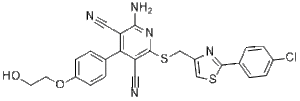Capadenoson
This product is for research use only, not for human use. We do not sell to patients.

For small sizes, please check our retail website as below: www.invivochem.com
| Size | Price | Stock |
|---|---|---|
| 100mg | $1450 | Check With Us |
| 250mg | $2590 | Check With Us |
| 500mg | $3885 | Check With Us |
Cat #: V4212 CAS #: 544417-40-5 Purity ≥ 98%
Description: Capadenoson (formerly also known as BAY 68-4986) is a novel, orally bioactive, potent and selective adenosine A1 receptor agonist.
Top Publications Citing Invivochem Products
Publications Citing InvivoChem Products
Product Promise

- Physicochemical and Storage Information
- Protocol
- Related Biological Data
- Stock Solution Preparation
- Quality Control Documentation
| Molecular Weight (MW) | 520.03 |
|---|---|
| Molecular Formula | C25H18ClN5O2S2 |
| CAS No. | 544417-40-5 |
| Storage | -20℃ for 3 years in powder formr |
| -80℃ for 2 years in solvent |
| Protocol | In Vitro | To further elucidate the pharmacological properties of Capadenson, GTP shift assays are performed with the standard full A1-agonist CCPA and the A1-antagonist 8-cyclopentyl-1,3-dipropylxanthine (DPCPX). CCPA shows a Ki value of 4.2 nM in the binding assay on rat cortical brain membranes. In the presence of 1 mM GTP this Ki value shifts to a value of 64 nM. Therefore the GTP shift for CCPA is 15. DPCPX shows a GTP shift of 1 with virtually identical Ki values in the absence and presence of GTP. Capadenson shows a Ki value of 24 nM in the binding assay. In the presence of 1 mM GTP this Ki value shifts to a value of 116 nM resulting in a GTP shift of 5 for Capadenoson |
|---|---|---|
| In Vivo | In the in vivo experiments, Wistar rats and SHR are pre-treated with Capadenoson at a concentration of 0.15 mg/kg for 5 days. On day 5, a stress test (physical restraint) is performed for 2 hours. The plasma concentration of Capadenoson measured 3 hours after drug intake remains constant in the 5 days prior to the restraint stress test and averaged 7.63 µg/L on day 4 and 5, respectively |
These protocols are for reference only. InvivoChem does not
independently validate these methods.
| Solvent volume to be added | Mass (the weight of a compound) | |||
|---|---|---|---|---|
| Mother liquor concentration | 1mg | 5mg | 10mg | 20mg |
| 1mM | 1.9230 mL | 9.6148 mL | 19.2297 mL | 38.4593 mL |
| 5mM | 0.3846 mL | 1.9230 mL | 3.8459 mL | 7.6919 mL |
| 10mM | 0.1923 mL | 0.9615 mL | 1.9230 mL | 3.8459 mL |
| 20mM | 0.0961 mL | 0.4807 mL | 0.9615 mL | 1.9230 mL |
The molarity calculator equation
Mass(g) = Concentration(mol/L) × Volume(L) × Molecular Weight(g/mol)
Mass
=
Concentration
×
Volume
×
Molecular Weight*
The dilution calculator equation
Concentration(start)
×
Volume(start)
=
Concentration(final)
×
Volume(final)
This equation is commonly abbreviated as: C1 V1 = C2 V2
Concentration(start)
C1
×
Volume(start)
V1
=
Concentration(final)
C2
×
Volume(final)
V2
Step One: Enter information below
Dosage mg/kg
Average weight of animals g
Dosing volume per animal µL
Number of animals
Step Two: Enter the in vivo formulation
%DMSO
+
%
+
%Tween 80
+
%ddH2O
Calculation Results:
Working concentration:
mg/ml;
Method for preparing DMSO master liquid:
mg
drug pre-dissolved in
µL
DMSO(Master liquid concentration
mg/mL)
,Please contact us first if the concentration exceeds the DMSO solubility of the batch of drug.
Method for preparing in vivo formulation:
Take
µL
DMSO master liquid, next add
µL
PEG300, mix and clarify, next add
µL
Tween 80,mix and clarify, next add
µL
ddH2O,mix and clarify.
Note:
- (1) Please be sure that the solution is clear before the addition of next solvent. Dissolution methods like vortex, ultrasound or warming and heat may be used to aid dissolving.
- (2) Be sure to add the solvent(s) in order.




































